25 Best Examples of LinkedIn & Facebook Lead Gen Forms, Plus Full Setup Guide
25 Best Examples of LinkedIn & Facebook Lead Gen Forms, Plus Full Setup Guide

You have the business, the resources, and the time — all you need is the clientele to move your business forward. Unfortunately, recruiting people to your network isn't the easiest task. When you rely on LinkedIn Premium accounts and Facebook business pages to garner interest in your company, you end up having to sift through a whole host of dead-end leads, like:
- The Mindless Clicker: The consumer who has zero interest in following your business but does so because they were a) invited to like the page, b) saw a headline that piqued their interest, or c) lives by the mantra, "follow many, get refollowed"
- The Interested, but Not Convinced: The consumer who wants to buy your product but never has enough money or doesn't see the worth of spending extra for your product
- The Support Group: The consumer who has no intention of buying anything but believes in your product and engages with your brand
- The Wish Lister: The consumer who browses through your product list and adds things to their cart, only to abandon it because they feel they don't want to buy it themselves
What you need, in this case, are effective leads. You need people who are not only interested in your company but who want to actively follow and learn about your company, too. In other words, you want to target and convert your customers in one shot.
Fortunately, online marketing has been around long enough to innovate new ways to attract these people to your company. One method to convert leads is using lead generation forms. In this article, we will take you through the nitty-gritty of lead gen forms. We'll also give you 25 of the best examples of Facebook and LinkedIn lead gen forms, plus a full setup guide for your convenience.
What are lead gen forms?
Lead generation forms, or lead gen forms, are an online marketing tactic used by businesses and individuals to convert consumers to their service or product. It is largely used by business-to-business (B2B) companies. These are companies that operate wholesaler to retailer, to bypass the retailer's search engine and bring the consumer directly to their product. Of course, you don't have to be a B2B business to use lead gen forms.
A company will send out these forms to collect data from potential convertible consumers. The most common info that a business will ask for is contact info. While this may sound basic, it's so valuable to the company in question. The marketing team will follow up with the consumer via newsletter, personalized email, etc., to educate them on the product. There may also be additional lead generation forms within this follow-up that help the company narrow down its list.
When they feel they have a qualified customer, a salesperson will contact these people directly — or they'll be added to a special offer email list — in hopes of making a sale, donation, or whatever the company wants the customer to do.
25 examples of effective lead gen forms

Between LinkedIn and Facebook, your options for lead gen forms are diverse — there's something for everyone. We'll review them here and go more in-depth on how you can set these up for yourself.
As we go through this list, consider how well your usual calls to action (CTAs) would fit in with these formats. You will need to assign a specific CTA to each type of form you generate, even if it's an offbeat one. For instance, LinkedIn currently has five CTA options:
- Contact us
- Learn more
- Register
- Sign up
- Visit website
Meanwhile, Facebook's CTAs are fully customizable.
You'll also want to consider what form will best get you the kind of information you need. Remember, you're gaining leads here, not making a sale — yet. Though it can lead to a sale without needing follow-up (which is ideal), it's still not the end goal. The goal is to discover qualified, potential customers, so you can effectively convert them later.
The most common lead generation forms
Three basic lead gen forms hold as some of the best to this day. Even if you ignore the others on this list, take note of these three. You can do a lot with a little.
1. Contact forms
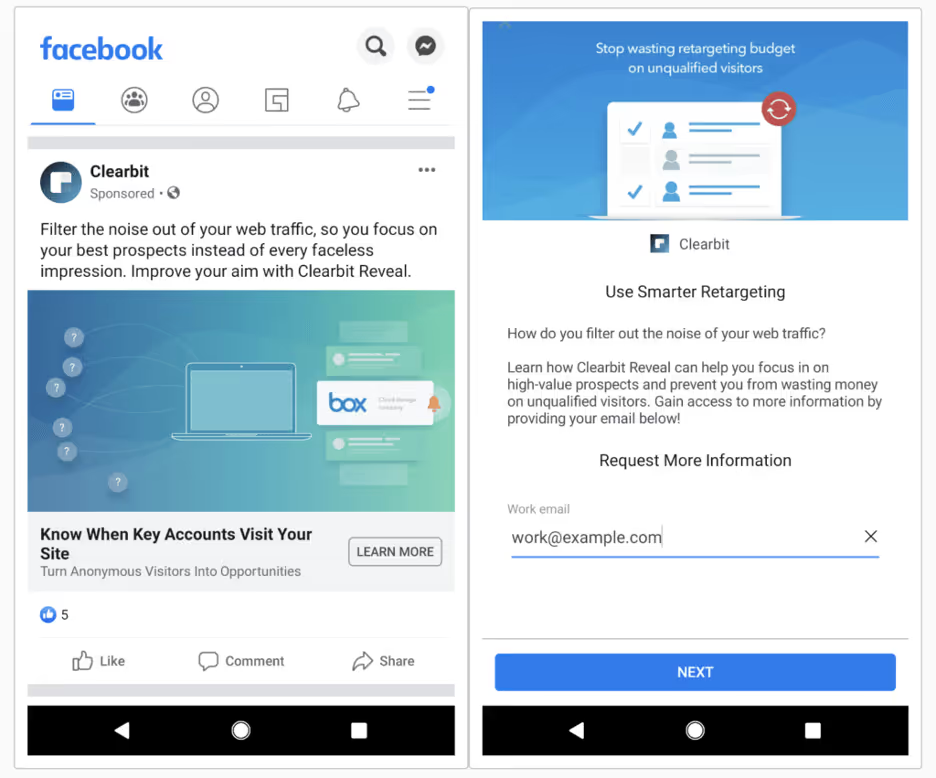
The most common of the most common, these lead gen forms collect a person's name, email, and, if applicable, phone number and mailing address. In lieu of a full address, some companies may prefer just to ask for a zip code. This way, the company can get a general idea of where they are generating the most interest.
2. Registration forms

It doesn't matter what someone is registering for. They need to provide their name, contact details, address (if you need to mail tickets), and potentially a "where did you hear about us?" The registration form also implies that the customer is receiving something in return, whether that be a free webinar, a series of newsletters, or a spot at a lecture or virtual concert.
3. Newsletter sign-ups

If someone is truly interested in your company, they'll want to stay on top of company news. That's why you should trust newsletter sign-ups as effective lead gen forms. Sure, some people may get sick of your newsletters, but they can always unsubscribe.
Niche forms
For more out-of-the-box thinking, here are some less common lead gen forms that are bound to get you results. These options begin to narrow down your audience and offer "rewards" in exchange for information. You may want to include a sign-up form and then redirect consumers to your website. You can do this on both LinkedIn and Facebook.
4. Whitepaper

A whitepaper is a document that highlights a certain issue, accomplishment, or aspect of a business. This could be industry trends, stock prices, etc. Whatever you decide to put in the whitepaper should be appealing enough for your target audience to want to read and convincing enough that you can sell your audience on your business.
5. Online course
A sign-up-driven technique, when you have people register for a course related to your product or business, you can bet that they'll convert. You may have more success on Facebook if the course is geared towards hobbyists.
6. Pre-launch registrations
You know you have a crowd excited for a new product, but you don't know who they are, so have them register for a launch event.
7. eBooks
An eBook is great for diving into a niche and a nice "gift" you can provide in exchange for someone's name and email.
8. Subscribe
Isn't subscribing the same as signing up? Kind of, but it sounds better. Call it semantics, but when you tell someone to subscribe, it implies that they will be receiving a recurring product, whether this is an email, YouTube videos, or a box of select products.
9. Downloads
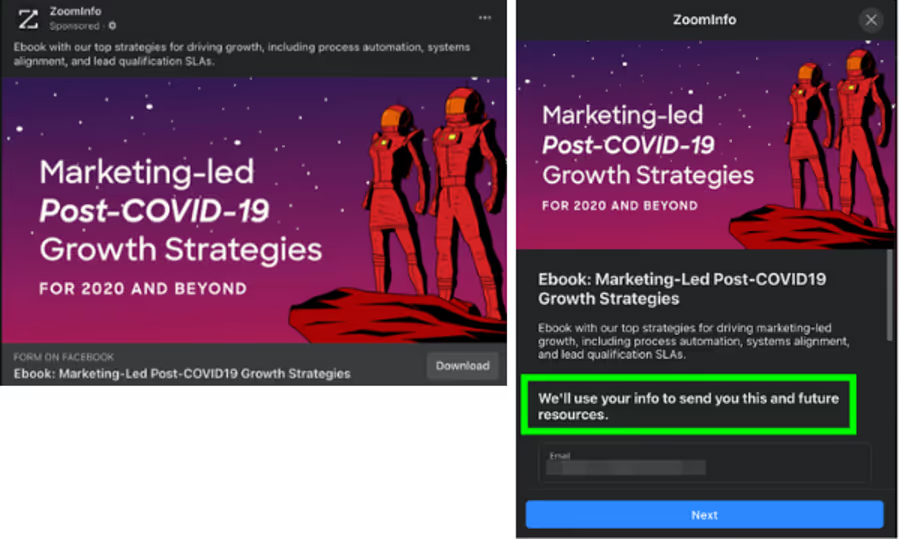
Downloads, in general, can get you great leads, even if only an email address. For instance, if you run a PDF conversion site, you can require people to provide their email before they can download the finished product. You'll have to make sure that you email a copy of this PDF to that address, but now that you know that person needs a PDF converter, you can follow up with information about premium PDF conversion services.
Business-oriented lead forms
Some lead forms are very business-forward. They gather leads because there is already business engagement, meaning someone wants to buy from you already. You just need to convince them.
10. "Learn more…" and "get more info"
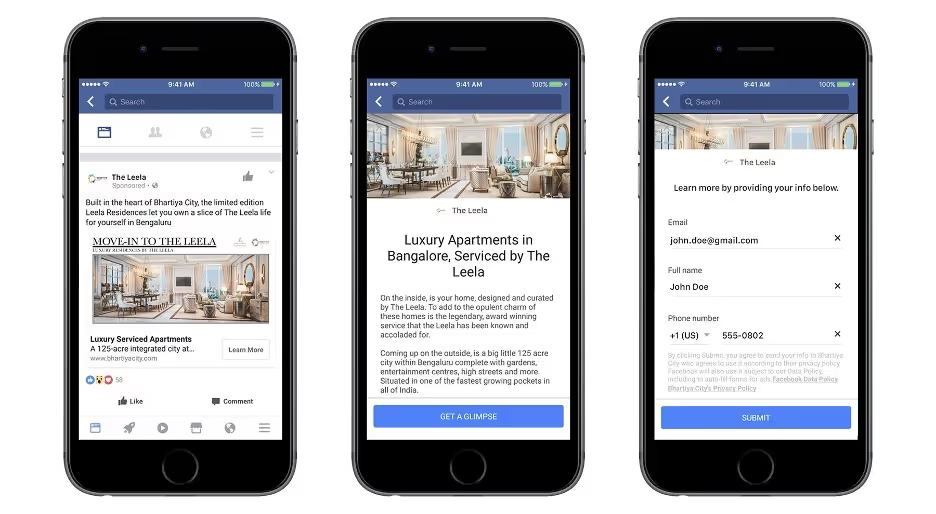
Common among individuals who run lifestyle programs and companies looking for franchisees, a "get more info" form is a promise to the consumer that you'll follow up with them. When someone fills out this form, you can generally assume that they want you to contact them. It may not be a serious inquiry, but it is a good lead.
11. Discount codes
Offer a discount code when someone signs up for a newsletter or your email list. This technique works better on Facebook than LinkedIn, as Facebook's business is more focused on consumables as opposed to employment and professional networking.
12. Request a quote
We like "request a quote" as a lead gen form because you are already engaging in real business without fully converting someone yet. It's like a half-conversion. The consumer is interested enough in your services that they want to know how much they'll have to pay but are still shopping around.
Consider following up with the customer over the phone to create a better rapport and build trust. You could also send a personalized email.
13. Apply now
You'll need to know what people are going to apply for, and you must be able to follow through with applications, but "apply now" might as well be handing you someone's money.
If a lead is applying to something regarding your business, they are interested in buying! They could apply for a credit card through your business, a job (in which case you're converting talent as opposed to consumers), or even a membership.
14. Special offer
Provide a special sales offer or discount to people who sign up for a membership or add themselves to your mailing list. Include a link to the sales offer landing page on your website, too.
15. Referral program
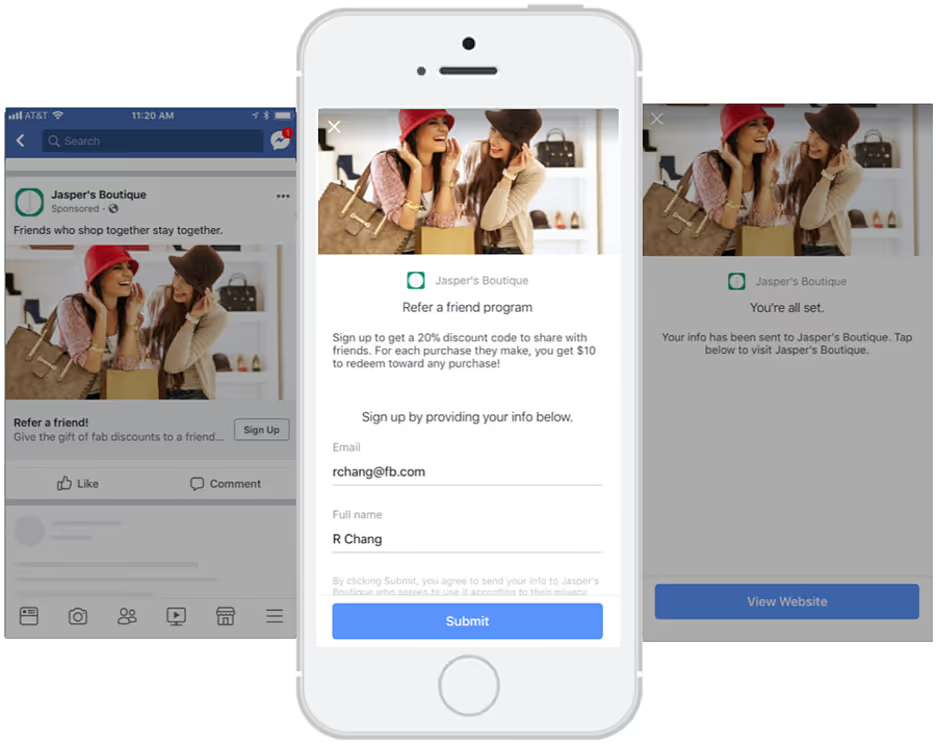
Offer a discount on your services if someone signs up their friends for your newsletter.
For the creative
Even lead forms can inspire people to be creative.
16. Community think tanks
Let your audience tell you what they want. Offer an opportunity for people to express their opinions about how a product should improve, what they feel is missing in existing products, etc. Then, have them sign up for your email list and keep them in the loop about your new product development.
17. Competitions and giveaways
Another effective lead gen form option for Facebook, hosting a competition or giveaway targets a specific audience and immediately gives you insight as to:
- Who they are
- What they like
- How well you'll be able to sell something to them
You'll also need their contact information. Offer to sign them up for your newsletter when they enter.
18. Social media hashtags and stories
How can a hashtag be a lead gen form? Easy — hashtags are topical communities. By looking through hashtags relevant to your brand, you can send personalized DMs or public replies to a potential customer. You can also create a tagged social media post leading people to a “link in bio” with a survey or newsletter sign-up.
Facebook social media stories, especially the "Ask a Question" feature, are a nice quick way to generate leads. You don't have to create a form, you can get specific, and anyone who responds is already watching you.
19. Blogging
Though LinkedIn and Facebook aren't technically blogs, you can still use them to post long-form content and link out to an actual blog of yours. If someone engages with you — we're talking comments on the post — the information you need about them is already there. Click on their profile and take what you need and can see. You can also encourage them to sign up to receive blog updates.
Cold and bold
What do we mean by "cold?" We mean uninitiated by the consumer. You are essentially contacting someone even if they didn't talk to you or they have no idea what your company is about. Though you may immediately think "telemarketing," remember that you aren't selling anything yet. You're just gathering lead information.
For example, educational institutions receive lists of students every year and cold call them to gauge and build interest in their school. However, you don't have to cold call anymore — there are other ways.
20. Cold email/message
Take a chance by sending an email with a lead gen form. The worst that could happen is that you end up in a spam folder or ignored. This is a great use of LinkedIn's message feature.
Cold emailing is a powerful technique when you use it correctly. If the recipient sees you as an innocuous institution with good intentions, especially if you encourage them to look at your LinkedIn or Facebook page, they are likely to answer.
21. Cold calls
We said there are other ways, but when you have access to a human lead gen form, take advantage of it. Cold calls can take people off guard, so beware! Try to only use cold calls for specific, important initiatives, like voting, education, or non-profits.
If successful, you can personalize intake on the spot and learn more about a lead than you could with set questions online. You can then direct them to your LinkedIn or Facebook page to sign up for a newsletter or other service.
22. Surveys
We include surveys in the cold section because no one actually asks for a survey. Rather, it's something that a company initiates to receive feedback. You can customize form questions in LinkedIn (and Facebook, but we recommend LinkedIn first) so that you can gain insight into pretty much any lead you want.
The most technical lead generation forms
These lead gen forms require a bit more skill and back-end know-how but are quite effective if you can master them.
23. SEO
Using SEO for lead generation can potentially get you thousands of leads a day. However, this depends on how well your website ranks and performs. You may be wondering, how is this a form?
Think of your SEO techniques, like implementing keywords, writing best practices, site speed, etc., as your form. If you want your lead gen form to rank higher in a search, you'll need to gather information on these factors. Then, when you do rank higher, the likelihood of conversion increases.
When it comes to LinkedIn and Facebook, if you want your profile to gain visibility and lead gen ads, you can:
- Participate in groups
- Use hashtags
- Publish posts
SEO applies here, too.
24. PPC ads
Facebook's PPC ads are like their regular lead gen ads, with the biggest difference being how you pay the company. In PPC ads, you pay per click or impression. For example, if you set your budget at 1,000 impressions, you only pay for the first 1,000 clicks on your ad — and then it's gone.
25. Smith.ai
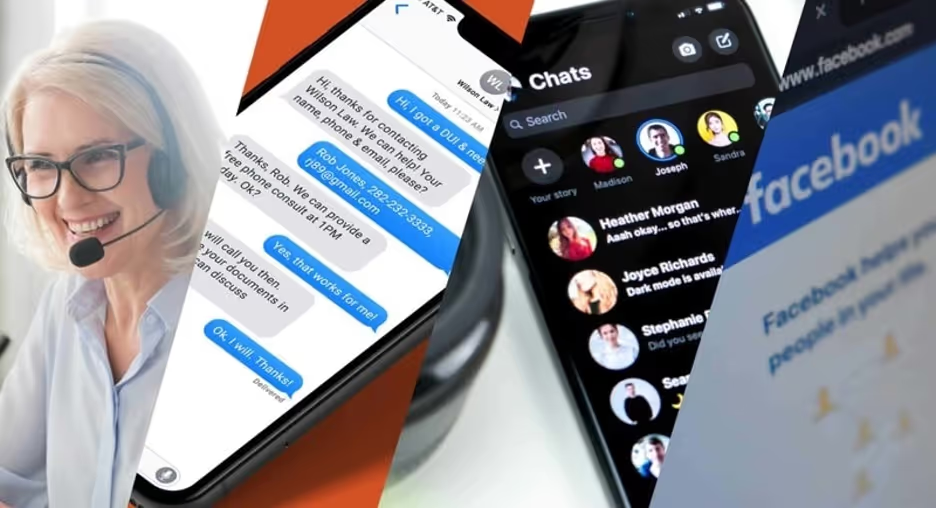
Smith.ai isn't "most technical" because it's challenging. It's "most technical" because its lead gen techniques are top-notch. Smith.ai intake agents will follow up with leads via Facebook messenger and other means to ensure you keep the sales funnel flowing.
Setting up LinkedIn lead gen forms
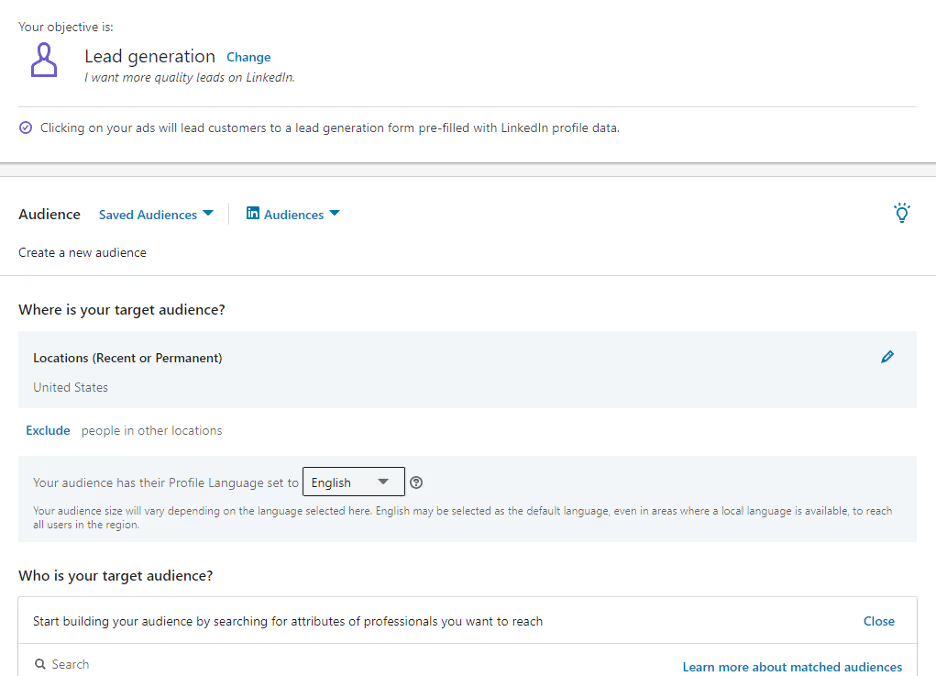
To get started with LinkedIn lead gen forms, you'll need to have an Ads account. Under this account, you should be assigned either to the Account Manager or Campaign Manager role. You can create new lead gen forms or attach existing ones to current campaigns by selecting "lead gen objective" as the campaign creation flow.
If you want to start a form from square one:
- Go to Account Assets > Campaign Manager > Account Name.
- Click Account Assets > Lead Gen Forms > Create Form.
- Make sure you select "lead gen" as an objective and define your target audience.
- Narrow down your audience by excluding any exceptions you want to make.
- Decide the format of your ad, single image, carousel, video, message, or conversation.
Customizing lead gen forms on LinkedIn
When it comes to the actual lead gen form itself, you'll first fill out key information, including the CTA and the privacy policy, which tells people how you collect and use their information. After the "heavy lifting," you can now customize the form. There are five categories from which you can choose:
- Education
- Demographic
- Contact
- Work
- Company
Most of this information should already be available on the person's LinkedIn profile, and some fields prepopulate accordingly. The only field that doesn't prepopulate is the person's gender. By default, LinkedIn includes first name, last name, and email address. You can keep this or change it, but you only get up to 12 fields.
Now, you can add up to three custom questions on the form. It doesn't seem like a lot, but these three questions can be the difference between a sign-up form and a survey. Combined with the correct ad format, you've just diversified how you can generate and collect leads on LinkedIn.
But you're not done yet! You still have to fill out your confirmation message. Go ahead and click Create when you're finished.
Message ads
Creating a message ad works differently from other ad forms. To start, attach a sender to the message (someone who is relevant and aware that you're doing this). They will need to approve this action. Once they have, you can form your ad, typing out the message, CTA, etc. Again, you can add custom questions, but you may only have 12 fields on the form. Fill out your confirmation message and click Create.
When you're ready, go ahead and launch the campaign.
Setting up Facebook lead gen forms
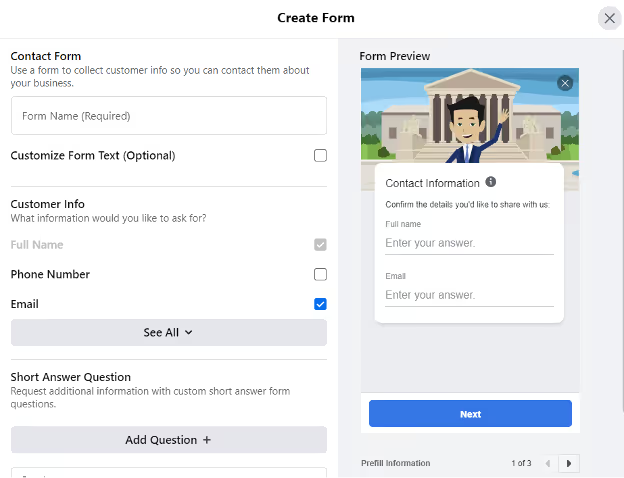
Facebook lead gen forms work a little differently, and, in our opinion, the platform is easier to work with. Both LinkedIn and Facebook have their places in the lead gen forms realm, but you really see who would benefit from what platform as you start to create the ad.
Go to your Facebook page and select Publishing Tools > Forms Library > +Create to make a form. You can either create a brand new form or duplicate an existing one if there's a template you want to use. Name your form and select your form type, either More Volume or Higher Intent.
More Volume will create a quick-to-complete and mobile-responsive form to help you bring in more leads. Higher Intent will give people the option to review their answers before submitting them.
There are different sections you'll need to fill out, similar to LinkedIn's process. In the Intro, provide any information or visual aids about your product. Moving onto questions, you can have up to 15, all of which may be custom. You have five question formats available:
- Multiple-choice
- Short answer
- Store locator
- Conditional
- Appointment request
You can also choose pre-filled questions.
Next, add your privacy policy text and custom CTA text (up to 60 characters long). Click Form Preview > Publish to complete your form. To use the form in an ad, click Boost. You'll select the video or image you want to appear in the ad campaign, as well as your budget and schedule. Finally, hit Promote to publish your ad.
Video and image specs
To optimize your videos and images in your lead gen form ads, use the following specifications.
Facebook images and video
The image file should be JPG or PNG, 1,080 x 1,080 pixels. Keep the aspect ratio 1:1. If you're using a video, the file should be MP4 or MOV. Ideally, the video should only be up to 15 seconds long. The aspect ratio is 4:5, and the video itself should have:
- Square pixels
- A fixed frame rate
- Progressive scan
- High-profile
- An H.264 video compression
LinkedIn images and video
Similar to Facebook, images should be JPG or PNG and no more than 5MB. If you're using a carousel format, only use 2-10 cards per ad and do not exceed 10MB per photo. LinkedIn will display single images at 1,200 x 627 pixels, with a width of 400 pixels. With carousel images, keep it at 1,080 x 1,080, aspect ratio 1:1.
For videos, you'll need an MP4 file no bigger than 200MB. Keep frame rate under 30 and audio less than 64KHz. The length of the video should be 15 seconds but can be longer if need be.
Lead gen best practices
You understand what lead gen forms are, what they do, and your options. But all of this means nothing if you cannot optimize them with best practices. Though best practices change with trends and people's attention spans, you should still implement all of the following that apply to your needs.
Ad rules apply
Just because you're collecting information doesn't mean you shouldn't treat this like a regular advertisement. Create an appealing design, and promote "rewards" for signing up or registering for a newsletter in a fun, catchy way. Be clear, concise, and bold.
Target your audience
Speaking of the audience, target them! If you are setting all of these specs on LinkedIn for your target audience, don't turn around and create a lead gen ad that doesn't appeal to them.
Be creative
You can gather information without making it seem like you're gathering information. Come up with creative ways to present your forms; use visual aids. Take advantage of the 15-second video to convey who you are as a brand.
If you have a particularly long survey, don't make someone scroll down the page endlessly. The boredom and utilitarian feel of the form is enough to make anyone navigate away. Instead, break up the survey into sections, and present them in a casual, animated way. Or, release them gradually over the course of your campaign.
Offer encouragement between sections, like, "You're almost there!" or "Just one more question, stick with us!"
Have a photo that pops
Don't use a photo that blends into the scenery. This is not the time for native ads. Bring color and flair to your brand and match your audience.
Inbound vs. outbound techniques
Decide if you want to use inbound or outbound lead generation forms. Inbound generation forms include SEO, social media engagement, and price-per-click campaigns. Outbound generation forms are cold calls, email marketing, and other forms of advertising. Basically, one is information you are asking for or actively seek out (outbound), and the other is consumer-driven (inbound).
Even though it may seem that LinkedIn and Facebook would fall strictly under the social media umbrella, they have purposefully incorporated outbound lead gen forms to increase your chances of converting someone. It's more a matter of identifying which techniques work best for your sales funnel.
If your business is business-to-consumer (B2C), using inbound techniques like social media engagement is helpful. B2Bs may find more success using outbound techniques instead. Whatever category you use, make sure to cater your form accordingly.
More is not more
Just because you can add custom questions doesn't mean you should. Only include what you need. "Keeping it simple" makes organizing your information and filling out the form easier for everyone.
Put effort into your “thank you”
Your lead gen form experience doesn't end until the user navigates away from the form screen. Be sincere in your thank you and provide any information about follow-up steps that may be relevant to them.
Use AI… and humans
AI was made to make things like lead generation forms easier for you. And no, AI is not a "robot" — it is a set of complex algorithms that you can program to respond in a human manner. These algorithms can "learn" how to answer questions. It's like the human brain if humans tried to recreate the human brain… which we are.
AI can recommend actions, make predictions, and tag and organize data based on what you've gathered from your forms. It can also be a type of lead generation form in itself. A simple AI chatbot — like what our team at Smith.ai offers — can handle basic customer questions so you won't lose a potential convert to confusion. It can also record conversations and gather contact information.
But you shouldn't ignore the human element, and Smith.ai plans for this. Our services include lead intake and outbound lead gen follow-up, getting back to leads quickly. Smith.ai agents then redirect these leads to your website, where you can engage with them personally.
Smith.ai is ready to take your lead generation to the next level
Just because this article is long doesn't mean that creating lead gen forms is difficult. The only problems you could possibly run into deal with budget and how well you can put together an ad. If you have the resources, absolutely give lead gen forms a try.
Our virtual receptionists and chatbots can take these potential leads that come in, screen out the dead-ends, and forward you the ones most likely to result in conversions. Our services also include:
- Appointment and call-back scheduling
- SMS messaging
- Payment collection
- Spam blocking
If you’re interested in learning more about working with us, we are happy to offer a complimentary 30-minute consultation. Smith.ai also offers a variety of services capped off by a 30-day money-back guarantee. If you’d like to chat with someone from our team right now, you can reach us 24/7 right here on our site or call (650) 727-6484.
Take the faster path to growth. Get Smith.ai today.
Key Areas to Explore
Technical Implementation Terms
Voice user interface (VUl) design
Speech recognition integration
Text-to-speech optimization
API connectivity and webhooks
Real-time data synchronization

Your submission has been received!

.avif)












.svg)



